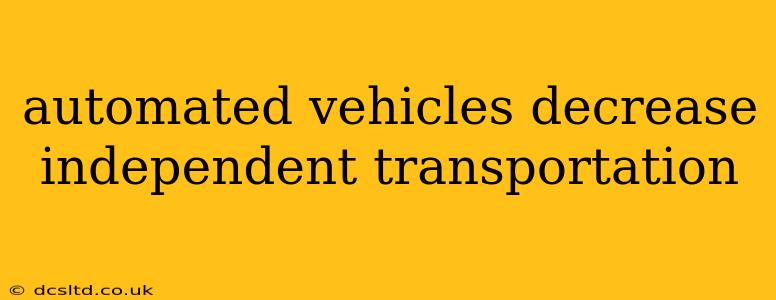Automated Vehicles: A Double-Edged Sword for Independent Transportation
The rise of automated vehicles (AVs), also known as self-driving cars, presents a complex picture for independent transportation. While promising increased accessibility and safety, they also raise concerns about decreased personal autonomy and potential societal shifts. This article delves into the multifaceted impact of AVs on individual transportation, exploring both the benefits and drawbacks.
Will self-driving cars make public transportation obsolete?
This is a crucial question, and the answer is likely "no," at least not entirely. While AVs offer door-to-door service, eliminating the need for walking to bus stops or train stations, public transportation serves a vital role in high-density areas. Public transit systems are often more efficient and cost-effective for moving large numbers of people, especially during peak hours. AVs might complement public transportation by providing "first/last mile" solutions, bridging the gap between homes and public transit hubs. However, the widespread adoption of AVs could potentially decrease reliance on public transportation in less densely populated areas, leading to challenges for maintaining existing services.
How will self-driving cars impact the elderly and disabled?
For the elderly and disabled, AVs offer a transformative potential. The ability to travel independently, without relying on others for transportation, significantly enhances their quality of life. This increased mobility opens opportunities for social interaction, access to healthcare, and participation in community activities – factors often limited by physical limitations or lack of accessible transportation. However, the cost of AV technology and accessibility features remain a significant barrier, ensuring equitable access for all remains a considerable challenge.
Could self-driving cars reduce the need for car ownership?
The potential for reduced car ownership is a key argument in favor of AVs. Ride-sharing services using AVs could offer a more affordable and convenient alternative to personal vehicle ownership, especially in urban areas with robust network coverage. This could lead to less traffic congestion, reduced parking demands, and a smaller environmental footprint from decreased car production. However, the transition to such a system requires substantial infrastructure development and overcoming public trust concerns regarding safety and reliability.
What are the job losses associated with the adoption of self-driving cars?
The shift to AVs undeniably poses a threat to numerous jobs, particularly in the transportation sector. Professional drivers – truckers, taxi drivers, bus drivers – face potential displacement. The scale of job losses is heavily debated, with some estimates predicting significant disruptions. However, new job opportunities are also likely to emerge in areas such as AV development, maintenance, and management of autonomous transportation systems. The transition will require proactive strategies to manage workforce retraining and ensure a just transition for displaced workers.
How will self-driving cars affect traffic congestion?
The impact of AVs on traffic congestion is a complex issue with no definitive answer. While optimized routing and coordinated movement of autonomous vehicles could potentially reduce congestion, the increased number of vehicles on the road due to increased accessibility could counteract these benefits. Furthermore, the initial deployment of AVs might cause disruptions as human drivers and AVs navigate alongside each other. The ultimate impact on traffic will depend on factors like the rate of AV adoption, infrastructure improvements, and the implementation of effective traffic management systems.
In conclusion, the effects of automated vehicles on independent transportation are multifaceted and far-reaching. While offering undeniable benefits, particularly for those with limited mobility, the transition also presents challenges requiring careful consideration and proactive planning. A balanced approach incorporating social, economic, and environmental factors is crucial to harnessing the potential of AVs while mitigating their potential drawbacks.
